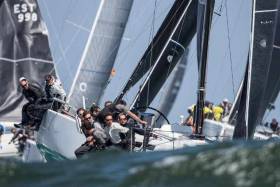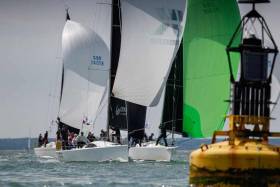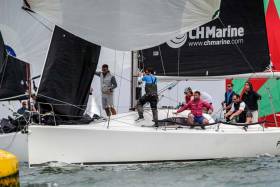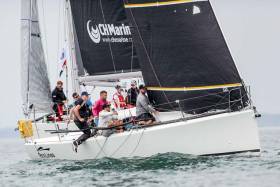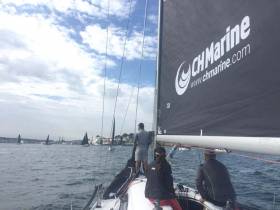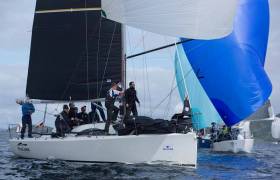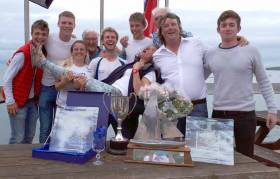Displaying items by tag: Fools Gold
Waterford Harbour's Rob McConnell sailing the Archambault A35 'Fools Gold' has moved up from 18th to 14th from a fleet of 49 after the first four races in Class C of The Hague Offshore Sailing World Championships 2018. The Sovereign's Cup champion has five races left to sail in an extremely competitive inaugural IRC/Offshore championships.
Full results are here.
In contrast to the past few days of light shifty winds, today's superb 12-17 knot southerly breeze made for fast and furious racing on all courses of The Hague Offshore Sailing World Championship 2018. And so even with a later 1300 start today, Principal Race Officer Peter Anink informed everyone two inshore races would be held to take advantage of the favorable conditions.
The southerly breeze combined with a south-flowing flood current to bring even more pressure on the water as well as some big waves, so all teams had to be at their best to avoid being over early at the starts and running into turning marks. With an impressive crowd of 49 boats on the start line of the south course area, Class C was particularly difficult to control, but had only one general recall in the day's second race while the A and B classes in the north course area had no start problems at all.
In the AB course area the High wind Triple Number rating option was selected by race managers for scoring both races with winds over 14 knots, while on the Class C course area the High option was used for the first race, and the Medium option for the second as the tide diminished in strength.
Continuing to perform like a well-honed machine, the Pac 52 Team Beau Geste (HKG) sailed well again today and put two more bullets on the scoreboard. Skipper Gavin Brady had compliments all around about the event, the venue and the racing.
 James Chalmers Bengal Magic, the British J35 that races with Irish sail numbers Photo: Sander Van Der Borch
James Chalmers Bengal Magic, the British J35 that races with Irish sail numbers Photo: Sander Van Der Borch
"In seven years of international campaigning, this has been the most friendly venue for support for our team. And we really enjoyed that long race...12 knots, flat water, clear skies: Karl said it was champagne sailing. If we had more races like this we would have more people in the sport for sure."
On the inshore races today, Brady said the competition with Tilmar Hansen's rival TP 52 Outsider (GER) has been helping to push them. "We were trading leads today, and as they keep getting better and better as they learn their new boat, we have to keep our game high."
Another Class A team that proved a threat to the two 52's was Bas de Voogd's Carkeek 40 Hitchhiker (NED), earning a second in the first inshore race of the day by defeating Outsider by only a few seconds in corrected time. This team has roots in the local Dutch offshore sailing scene having campaigned here for years, but recently with this boat has been active in the UK on the Fast 40+ class circuit.
"This has helped us learn a lot and improve our teamwork," says de Voogd. "But we made some changes to the boat last winter and are still getting used to them." Specifically, the team moved the rig aft 40 cm in the boat and moved the rudder forward 30 cm to improve their speed in class racing. Yet in the breezy conditions of today in high-speed offwind sailing with waves, a condition they haven't seen much in the Solent, they had some control issues in the second race.
"We're having a lot of fun in these waves, we just need to do more work on understanding the controls with the new set-up," he said.
In Class B the winner of the first inshore race was Harold Vermeulen's MAT 11.80 Leeloo (NED), whose wild orange and black graphics make her hard to hide on the race course. This good result temporarily pushed them up into second place in the standings behind class leader Santa, Claus Landmark's Landmark 43 from Norway. But a weak 17th place finish in the second race pushed them back into fifth...down, but certainly not out of contention, and the thrill of racing in fresh breeze and waves kept the team in buoyant spirits.
"For us this wind is so cool, we're a planing boat, so we sail very fast," said Vermeulen. "The first race went great, but we had a bad start in the second race, even though we managed to win something back. But one result doesn't do a lot in this fleet, the racing is so close. For us it's going to be tricky to score well in all the conditions we're up against this week because our boat isn't optimized like many others in our fleet. We're just enjoying a great week of sailing, and for the scoring it's so far, so good."
The team currently lying second in the Class B standings was not happy after yesterday's long race results and felt the event was sliding away from them.
"We were not happy that the long distance race had so much points value and had so much reaching and seemed to favour the boats with asymmetric spinnakers," said members of Martin Estlander X-41 Xini Freedom (FIN) last night. And yet this team has been a proven performer from years of one-design racing in the competitive X-41 class and they have used these skills to do well in many European and World Championships. They showed that today in earning their share of tied 4th and 2nd places respectively, in the first and second inshore races. It's no wonder that two other Baltic-based X-41's are also in the top ten - Tiit Vihul's Olympic (EST) in fourth and Soren Junker's Nexus (DEN) in 9th.
Top-ten excellence in windward/leeward course racing has also helped the team lying now in third place in Class B, Alex Sastre's Farr 40 Mr Brightside (NED), on the strength of two 5th places in the offshore races and scores of 2-9 today.
In Class C yesterday's leader, Patrik Forsgren's modified First 36.7 Pro4U (SWE), did well enough to continue to stay atop the leaderboard, but they said it has not been without effort.
"This is an incredibly tight fleet," said Anders Bjork, spinnaker trimmer on Pro4U. "You make the smallest mistakes and you're going to be out of the top ten easily."
The mistake they made today to push them back into 13th in the first race was once again hitting a mark, this time the leeward gate, and then having to do a penalty turn before continuing on the second upwind leg. But the team is upbeat and confident.
"We are actually happy with the scoring in both IRC and ORC, and find it to be pretty fair. The teams that are sailing well are enjoying close racing, and this is the way it should be at this level."
And based on their strong offshore race scores yesterday and reasonable inshore results today, Heiko Pasler's X-362 Sport Static Electric (GER) has kept their second place position in the Class C standings.
Sometimes this close inshore racing gets too close, and the International Jury chaired by Jan Stage had tonight to sort out five protests, all involving Class B and C competitors. Unfortunately Willem Ellemeet's Dufour 40 Flying Dolphin (NED) was caught in the net and penalized DSQ for a port-starboard incident with Alain Bornet's J/109 Jai Alai (NED) in Race 2, driving them from being 3rd place in the standings to much deeper and allowing Kai Mares's Italia 9.98 Immac Fram (GER) to take their place.
Xini Freedom is also in the protest queue tonight, so the morning may reveal new top three standings in Class B too...or not.
Tomorrow inshore racing continues, with an earlier start time of 11:00, and a wind forecast in the light to moderate 7-11 knot range. The first race tomorrow will be the fifth in the series, and thus the worst scores among all but the long offshore race will be discarded to further shuffle the standings. The remaining five inshore races scheduled will need to be completed by the final day Friday.
Ireland's sole entry in the IRC European Championships has finished a creditable fourth overall in Cowes today. Waterford Harbour's A35 yacht 'Fools Gold' skippered by Rob McConnell was a consistent performer in the 12-boat division three fleet, maintaining fourth or fifth place for the duration of the week-long event.
The immaculately sailed J Lance 12 has been crowned IRC European champion for 2018. The French J/112e skippered by Didier le Moal seemed never to put a foot wrong in the latter stages of this week-long regatta run from Cowes by the Royal Ocean Racing Club.
"It's great - I didn't expect that," said le Moal of claiming the IRC Europeans title. "First of all we wanted to win our class, but this is fabulous. It concludes the wonderful week we've had. If you enjoy racing, we have been in paradise. The weather, sun, light winds, heavy winds, big tides - everything you could expect to enjoy from racing, we've had."
Winning today's first windward-leeward race, held in 15-20 knot winds, was the French team's sixth bullet out of ten races. For the final big breeze, double points scoring, round the cans race, the French didn't have the class win secured, so played it safe. "The wind was increasing a bit so we preferred to sail safely because we had a big lead. We just needed to finish, not last, but fifth or sixth to win," explained J Lance 12's navigator and team secret weapon Nicolas Lunven, the reigning Solitaire du Figaro champion. With the wind gusting into the 30s they avoided gybing the spinnaker, to avoid breakage.
In addition to Lunven, le Moal and Frederic Bouvier, who are respectively President and Sales Manager of J Composites, European builder of the J/Boats range of yachts, the J Lance 12 crew of Christophe and Cyrille Cremades, Jean Francois Nevo, Jean-Michel Roux and Cyrille Teston are all friends who have sailed with le Moal for years.
"It is our third season on this type of boat, so we know exactly how it works," continued le Moal. "We had a very, very good navigator - to be fast is one thing, but to be fast on the right side is perfect. We are not so good reaching, but upwind the boat is so fast, it helps you recover."
Today's final race in IRC Three was won by Ed Fishwick's Redshift Reloaded with Shaitan second, after an impressive conclusion to her regatta rolling J Lance 12 within metres of the line. Nonetheless Shaitan finished second overall on 50 points to J Lance 12's 20.5.
As in IRC Three, so in IRC One South African Mike Bartholomew's GP42 Tokoloshe won today's first race and held a commanding lead going into the finale. But in this she was less conservative than her French counterpart. "It was very lively and variable - a difficult day," said Bartholomew. In the last race, Tokoloshe blew out the tack of her jib and then couldn't unfurl the Code 0 on one of the reaching legs. This allowed James Neville's HH42 Ino XXX to overtake them, but ultimately this landed Andy Williams' Ker 40 Keronimo her first bullet of the IRC Europeans.
While IRC One and Three were all but decided going into today's final race, this was not the case in IRC Two. The day started with five boats within eight points of first. Winning yesterday's final race, Frans and Carla Rodenburg's First 40 Elke had pulled up to fourth place in IRC Two. On a roll, the Dutch followed this up with another bullet in today's first windward-leeward. At this point sistership Adventurer should have had IRC Two sewn up, but she suffered a deep result in the last race in which Tom Kneen's JPK 1180 Sunrise picked up her second bullet of the regatta.
Alex & Andy Moore's First 40 TiLT Racing picked up second in this race having split from the fleet to go south of the Brambles Bank, resulting in a photo finish with Elke. A third place for Elke on corrected time ahead of RORC Admiral Andrew McIrvine's La Réponse was enough to secure the Dutch victory in IRC Two by a single point.
Rodenburg and his crew were ecstatic on hearing of their win: "We didn't know how the second race ended up, but we were sure we were on the podium if we did well," he said. "We are not used to round the cans, but the bigger winds were good for us."
In fact Elke's winning margin would have been larger until they suffered a broach. "We were gybing and there was a gust of 32 knots at just the wrong moment," explained Rodenburg. "I have enjoyed the IRC Europeans very much. It is great racing here as the organisation is very good, the information from the Race Committee is great and they tell us what they are thinking, so we enjoy racing here."
Celtic Team Wins the 14th Commodores' Cup
Keronimo being top scoring IRC One boat today made up for the mixed-results from her Celtic Team team mates - Jean-Eudes Renier's JPK 1080 Shaitan and the First 40 Adventurer, chartered this week to Scottish adventurer Jock Wishart. They scored 12-4 and 4-22 respectively in today's races. This confirmed Commodores' Cup victory for the Celtic Team, who have led the RORC's biennial race for three boat teams with Corinthian crews (this year running in conjunction with the IRC Europeans). However this was with the lower margin than yesterday - 140.5 points to second placed GBR-RORC's 170, the British having had an outstanding day, with La Réponse scoring 2-8, Sunrise 5-2 and Redshift Reloaded 3-2.
Celtic Team leader Jock Wishart, who sailed this week on Adventurer, was emotional upon having his long-sought Commodores' Cup victory confirmed. "All the hard work has paid off, although I would have liked to have won IRC Two as well.
"It became more and more evident as we came through, that we had done a lot of work and thought it through. Some of the early races showed that our thinking was working out: The crew work was brilliant, consistently on the podium in all of the classes - it was consistency, consistency, consistency. This win is something I've been dreaming about for a long time. We were last in the previous Commodores' Cup and this time we almost ran away with it."
Chris Stone, Racing Manager of the Royal Ocean Racing Club commented: "The IRC Europeans and Commodores' Cup have been an overriding success and all the competitors are happy. The racing has been a complete test with the full range of strong tides, heavy weather, light conditions and sun and rain. There were a couple of stand-out performances and I congratulate J Lance 12 crew as worthy winners. Otherwise the racing was incredibly close at this third European Championship showing that IRC remains in great health."
Light winds and strong tides may have made for a difficult first half to the Royal Ocean Racing Club's combined IRC European Championship and Commodores' Cup, but Hampshire Tourist Board conditions graced the Solent for day four of racing where Ireland's sole entry, Fools Gold, in IRC three stays fifth overall.
With a southwesterly wind that peaked at around 15 knots countering a powerful ebb tide, PRO Stuart Childerley set a 'classic Cowes Week' course, which for IRC One comprised a 25.7 mile long romp around the cans in the central and western Solent, with a finish for all three classes off The Green in Cowes.
The competition was made all the more interesting with variations in the courses between the three classes early on that left all but the biggest in IRC One racing alongside boats in the smaller classes. Plus there was an ultra-challenging start with two knot spring tides pushing the boats across the line. As Tor McLaren, owner of the MAT 1180 Gallivanter described it: "It was the type of start where if you got it wrong you were going home - not something you would ever want to attempt again."
Once again the two FAST 40+s, Michael Bartholomew's former GP42 Tokoloshe II and James Neville's HH42 Ino XXX led the charge, with the faster Tokoloshe II sailing to her rating to win the race overall. Yesterday's round the cans winner, Robert Bicket's Club Swan 42 Fargo, ended up third with Gallivanter fourth.
"It was a brutal race, but it was also one of the best days we have had with the boat," continued McLaren, whose largely youth crew on Gallivanter, which includes two 19-year-olds, has been fighting their equally-rated sistership, Christian Zugel's Tschuss this week. "It's been like nautical boxing: They kept coming back to give us another punch."
Sadly today's racing didn't go well for everyone and Andy Williams' Ker 40 Keronimo in particular suffered with a bad spinnaker wrap on the first run, followed by a low tide grounding on Egypt Point within sight of the finish. "We were in among seven other boats and everyone was trying to avoid everyone else," admitted Keronimo's Kevin Sproul. "Everyone had their heads in the boat a bit too much - we waited five seconds too long to gybe." Fortunately no one was injured in the incident that saw the boat stop dead from 10 knots. Both keel and rudder struck solidly and tonight Keronimo is out of the water being surveyed for damage at Hamble Yacht Services.
King 40s and Beneteau-built First 40s are quite different boats but were travelling at near identical speeds around the IRC Two course in today's conditions. In fact once Roger Bowden's King 40 Nifty had edged ahead, about the only position change came when RORC Admiral Andrew McIrvine's First 40 La Réponse rolled sistership Adventurer, campaigned this week by Jock Wishart.
As McIrvine explained: "We were absolutely neck and neck with Adventurer: Going down the runs, whatever we did we couldn't get past them until we got to one of the gybe marks when they tried to luff us and we sneaked inside. From there we extended. Then on the last beat, for some reason, we seemed tweaked up much better and extended again. It remained nerve racking all the way down the last run because we had to cover them. They are really similar boats.
Ultimately La Réponse won the race by one minute seven seconds from her sistership, despite a last ditch attempt at distraction tactics by Wishart's crew on Adventurer. At the end of day four she trails the IRC Two leader Nifty by just two points.
The two horse race in IRC Three is in danger of becoming a three horse one, with Michael Mollmann's X-37 Hansen having a difficult day, scoring a 12th, despite a worthy effort at a port tack start. This result the Danish team has immediately thrown now that the first discards have come into play. Meanwhile IRC Three had another winner today in the French First 40.7 Pen Koent of Emmanuel Le Men and his crew from Val-André in northern Brittany.
"We had a very good start -the type of start you do once every 10 years," mused Le Men. "We tacked very quickly at the buoy and on the first run we were first and after that we were with J Lance 12 and Shaitan, changing places. On the last run we were still with J Lance 12, but she gives us some time with her rating. Our boat is quite old - it is good for windward-leewards in not too much wind. The new boats go quicker in waves and heavy wind."
J Lance 12 had managed to edge in front at the Hampstead Ledge weather mark and finished second overall, but tonight continues to lead IRC Three by two points from Hansen. Racing on board Didier Le Moal's J/112e is reigning Solitaire du Figaro champion and Volvo Ocean Race navigator Nicolas Lunven. "Today was a perfectly typical race in the Solent with 12-15 knots, strong tide, wonderful weather, beautiful land space," said Lunven. "The wind was against the tide, but the sea state was quite nice. I was expecting more choppy waves. It was the first race of the Championship with more than 8 knots. It was a very nice race."
In the Commodores' Cup the Celtic Team, comprising Adventurer, Shaitan and Keronimo is still leading, but whether this continues remains in the balance, dependent upon the extent of the damage to Keronimo and whether/how quickly she can be repaired after her grounding.
Today the IRC European Championship fleet will be sailing a race round the Isle of Wight. This will be on an anti-clockwise course scheduled to start at 0900. However, the forecast indicates this coinciding with winds gusting to 30+ knots.
A third light, tricky day with strong tides at the Royal Ocean Racing Club's IRC Europeans and Commodores' Cup saw a lengthy round the cans course in the central Solent just completed before the wind shut down. After a wait, the skies darkened, the temperature plummeted as a southeasterly wind filled in, lasting just long enough for a singleton windward-leeward to be held for the three classes.
Ireland's sole entry in the competition, the Waterford Harbour A35, Fools Gold, skippered by Rob McConnell is lying fifth in IRC division three.
Provisional Results can be found here
A powerful flood tide off Osborne Bay, pushing boats down towards the pin presented some novel problems along the start line of today's first race. In the starts for each of the three classes, boats were called over early. In IRC One Robert Bicket's Club Swan 42 Fargo was OCS, but remarkably went on to win the complex course, criss-crossing the central-eastern Solent on different points of sail, in varying tidal states.
"We had a few things go our way - a Swan 42 is a great boat in 8 knots of breeze and flat water," observed Bicket, racing his new boat's first regatta with a crew, including several former Solent legends prised from retirement. Thanks to the variable winds and strong tides, there were a few park-ups around the race course and these seemed to work very much in the blue Swan's favour. "We had a few favourable compressions and some good mark roundings, but mainly we just stayed out of trouble," concluded Bicket.
Fargo's victory in race one came at Ino XXX's expense. "We thought we'd won the first race until the wind disappeared 100m from the line and everyone else came in with new breeze," observed owner James Neville. However he and the crew of his HH42 were compensated by winning today's second race, ahead of Mike Bartholomew's higher-rated Tokoloshe II. "We are having a good few days," Neville continued. "We just need more wind, but Stuart [Childerley - PRO] has done a good job keeping things on the road."
Nonetheless, the immaculately consistent Tokoloshe II continues to lead IRC One with no scores lower than second, leaving her five points clear of Andy Williams' Keronimo, with Ino XXX third.
While the First 40s were in the chocolates yesterday, the King 40s fought back in IRC Two today. A 3-3 for Nifty propelled Roger Bowden's team back into the lead, while the Blair family's Cobra managed a convincing win in today's first race, but bombed in the second, leaving her fourth. However the day belonged to Scots Rod Stuart and Bill Ram on their Corby 37 Aurora, which posted a 2-1 elevating her to second in class, three points astern of Nifty.
In the round the cans race, Cobra managed to speed away in clear air, but Aurora defended second well. "The windward start was good for us as we prefer windward-leewards," confided Stuart. "We rounded the first buoy in second in front of the First 40s. When we do that we can generally keep our position, although it's tough in a 12-year-old boat."
As in IRC One, the final tight reach back towards the Isle of Wight into even lighter airs compressed the fleet. "The lead we'd built up became challenged, but it was fine - we then had a great light beat against the tide," continued Stuart. "We are enjoying it, but the very light winds make it challenging."
IRC Three is developing into a two horse race between Michael Mollmann's X-37 Hansen and Didier Le Moal's J/112e J Lance 12. Today definitely belonged to the French who won both races. They now lead, one point ahead of the Danes who posted a 3-2 today.
Jean-Eudes Renier's JPK 1080 Shaitan, chartered to Scottish adventurer Jock Wishart was second in today's first race, but, showing a lack of consistency typical across this fleet thanks to the awkward conditions, was eighth in race two.
As was the case with Fargo in IRC One, so Shaitan was called OCS in today's first race but recovered well. "It was a pushy line," recounted jib trimmer Ruaridh Wright, who at 22 is one of several young Scottish sailors competing. "We fought our way through all the dirt, just finding lanes, got to the right side of the course and came out at the top mark in fourth or fifth. It was a constant battle to keep the boat moving. When we reached the other side of the Solent we managed to get away a bit, while the boats ahead fell into a hole in Osborne Bay. We managed to overtake another two boats on the way in- it was a scrappy fight, but we came out alright."
Kings High on the rise as the Celtic Team reasserts itself
In the Commodores' Cup, Jock Wishart's Celtic Team managed to build itself a cushion on day three of the competition and is now 19 points in front of Kings High, comprising the two King 40s, Nifty and Cobra, plus Mike Bridge's Elan 37 Elaine racing in IRC Three. This was despite the Celtic Team's Shaitan along with her team mates, the First 40 Adventurer and Andrew Williams' Ker 40 Keronimo all experiencing mixed results today.
A change of schedule for the remaining four days of the IRC European Championship and Commodores' Cup was announced this evening, with the offshore race, originally due to take place over Wednesday-Thursday now replaced by a race around the Isle of Wight on Thursday. This race was started yesterday but abandoned due to light wind.
Fortunately, good breeze is forecast from tomorrow afternoon for the remainder of the week, with the strongest set to coincide with the rescheduled lap of the Isle of Wight. Inshore races will take place on the remaining days.
Waterford Harbour yacht Fools Gold skippered by Rob McConnell was the winner of the second race of the IRC European Championships in Cowes yesterday.
In IRC Three, Dane Michael Mollmann and his immaculately sailed X-37 Hansen put in a 3-1 today, with the Irish team, helmed by Roy Darrer, on the A-35 Fools Gold winning the day's first race.
"Apart from the Danish leaders, we're the only team to have a race win in the bag. Unfortunately, the second race did not go to plan but we're quite happy so far", McConnell told Afloat.ie
The Irish boat now moves up from fifth to fourth overall in the 12–boat fleet. Results are here.
McConnell's crew, limited to eight, will be similar to the team that won the 2017 Sovereign's Cup and also the IRC Welsh Championships. 2004 Olympian Tom Fitzpatrick is tactician, Darrer is helmsman, Skipper McConnell is mainsail trimmer, Graham Curran is trimmer number one, Dougie Power is trimmer number two, Brian O'Donnell is mastman, Lisa Tait is in the Pit. Chris Frost is onboard as navigator for the Solent event.
The Danes now hold a three point lead overall, while in second overall is the J/112e J Lance 12 skippered by France's Didier Le Moal, Managing Director of the J/Boats European builder J Composites. They scored a 2-4, although Le Moal admitted: "We are not used to downwind starts." Le Moal's crew, that for this event includes reigning Solitaire du Figaro champion and Volvo Ocean Race navigator Nicolas Lunven, has sailed together for many years, and in fact, Le Moal remembers sailing the first Commodores' Cup here back in 1992 with a French team.
"Apart from the Danish leaders, we're the only team to have a race win in the bag" – Rob McConnell, Skipper, Fools Gold
The Azores high-pressure system encroaching on the UK is bringing summer to the Solent, but making life awkward for the race officers at the Royal Ocean Racing Club's IRC European Championship and Commodores' Cup.
The much-anticipated race around the Isle of Wight got away on time at 0930 BST from the Royal Yacht Squadron line. But just under two hours later the wind died and the race was abandoned, although not before several competitors had kedged. With the boats returned to Cowes Yacht Haven, patience won out and the gradient breeze somehow managed to overcome the thermal. This allowed for two round the cans races to be held in the central Solent, the wind even creeping into the teens towards the end of the second race. The two inshore races were held near the Brambles Bank with reaching and running starts respectively.
While there are three classes competing this week, there are also numerous 'races within races'. In IRC Two the King 40 sisterships Cobra and Nifty enjoyed near match racing in today's first race, finishing first and second respectively. For the Blair family, this was payback - in yesterday's race they had been forced to watch the massive lead Cobra had pulled out evaporate as they fell into a hole. "It was frustrating because we showed what we could do," recounted skipper Stevie Beckett. "So we have just been biding our time." Unfortunately, in the second race the whole fleet compressed as the backmarkers brought in the new breeze, causing Nifty and Cobra to finish fifth and ninth respectively.
Their loss was the First 40s' gain with RORC Admiral Andrew McIrvine's La Réponse winning today's second race ahead of sistership Adventurer, being campaigned here by Scot Jock Wishart. These two now lead IRC Two.
"We had a very good day," admitted McIrvine, albeit trying to forget the start of the race he ultimately won, when La Réponse's spinnaker accidentally found itself hoisted by a corner other than the head. "We managed to get into some not very good positions, but it was when we overtook Nifty that we knew we were doing well. The boat was going fine, especially downwind when we are always quick." It was possibly the lengthy downwind against the tide to the finish in building breeze that helped La Réponse claim today's second race.
In IRC One, the FAST 40+s, Michael Bartholomew's former GP42 Tokoloshe II and James Neville's HH42 Ino XXX continue to set the pace. Tokoloshe II claimed her second bullet in race one, but the FAST 40+ grip was broken in race two when the Mat 1180 Gallivanter prevailed; Tor McLaren and his young crew enjoying great racing this week against their sistership, American Christian Zugel's Tschuss.
After Tokoloshe II the most consistent performance of the day came from Andy Williams' team on the Ker 40 Keronimo, posting a 2-3.
"A difficult day on the water, but we are very pleased," said Williams. "All of the fleets are tight and the courses and the downwind starts were interesting - a bit hairy in the corners with lots of boats coming in together."
Celtic Team clings on in Commodores' Cup
The Celtic Team, managed by renowned Scottish adventurer Jock Wishart, today established a lead in the Commodores' Cup, although this was despite the First 40 Adventurer, Wishart is campaigning here, suffering a set back when the Southampton Water pilot boats prevented her from passing ahead of a container ship as it navigated its way out of the Solent. While Adventurer was the team's top scoring boat yesterday, today it was the turn of Keronimo. The Ker 40 has a long illustrious history in the Commodores' Cup, from its first outing when it won as part of the GBR Red team in the hands of Jonathan Goring in 2012.
Crewman then, as well as this week was Scottish sailmaker and mainsheet trimmer, Kevin Sproul. "It's brilliant," said Sproul of the boat that from year dot is recognisable from the 'HH' it has emblazoned on its bow. "It is a good boat and they have a really good crew and they sail the boat well. Relatively speaking we haven't put a foot wrong."
Although Sproul is on mainsheet, he has been contributing to the tactics and said it was a good call to abandon today's race around the Isle of Wight. "We ended up having two good races and finished in 15-16 knots - proper breeze. But it was an odd day - the wind was further north than we thought. And what was good for the tide wasn't necessarily good for wind, especially on the last run - we ran along the edge of the Brambles Bank in shallow water and then got more pressure and were able to dive down and that was a massive gain, just staying with the tide."
The Celtic Team now holds a six-point lead over Lastminute. EU, the team comprising the IRC Three leader Hansen, Robert Bickett's newly acquired Club Swan 42 Fargo and the J/122e Juno of Christopher Daniel. La Réponse's outstanding day has elevated their GBR - RORC team (that also includes Tom Kneen's new JPK 1180 Sunrise and Ed Fishwick's Sun Fast 3600 Redshift Reloaded), from last place to fifth overall.
Today the forecast is again light and the intention is to try for two inshore races. Whether one or two races is held will determine the schedule for the remaining four days of this IRC European Championship and Commodores' Cup.
IRC Report by James Boyd
There was a tricky start to the IRC European Championships for Ireland's sole entry Fools Gold from Waterford Harbour Sailing Club but the Rob McConnell skippered entry is still very much in the hunt and lies fifth from 12 starters in class three after only one race sailed so far in Cowes.
With such a light forecast, the Royal Ocean Racing Club's on-the-water officials, led by PRO Stuart Childerley, did well to complete one race on the opening day of the Europeans, incorporating the Commodores' Cup. Unfortunately the 5-7 knot north-northeasterly wind, all but disappeared just prior to the final IRC Two and Three boats finishing. After sending the fleet back to port, the PRO called it a day just before 1500 BST.
While only one race was held on the central Solent, there were some shining performances, none more so than the X-37 Hanson of Dane Michael Mollmann. Hansen not only beat all of her IRC Three rivals, but finished amid the front-runners in IRC Two.
IRC Two also had a run-away leader on the water in the Blair family's King 40 Cobra, however, they lost out a lot as the wind shut down on the final leg. This allowed their rivals on Roger Bowden's sistership, Nifty to live up to her name, sidestepping the stationary Cobra.
There was another run-away winner and an on-the-water lead change in IRC One, where James Neville's HH42 INO XXX led around the top mark only to be rolled by South African Mike Bartholomew's former GP42 Tokoloshe II on the first downwind. "We split from them and were going a bit quicker," explained Bartholomew. "It was pleasant enough, very shifty and the breeze was up and down, but we like that light stuff - the 40s are all quick in that." The FAST40+ yachts romped around the course and also benefitted from completing the last run before the breeze subsided.
Seven three boat teams have emerged to compete in this year's Commodores' Cup, being scored jointly with the IRC Europeans. After one race it is close, with the Celtic Team (Shaitan-Adventurer-Keronimo) tied at the top with Lastminute.EU (Hansen-Fargo-Juno) and just one point ahead of Haribo (Oui-Tilt Racing-Selma Racing). The Celtic Team, supported by Aberdeen Standard, benefitted today from podium finishes by both Adventurer and Keronimo.
Results here
As soon as Howth's Wave Regatta ends next Monday, Ireland's sole entry in the IRC European Championships heads for Cowes on the Isle of Wight where the Waterford A35 Fools Gold skippered by Rob McConnell is flying the flag for ICRA interests.
The Irish yacht will be hoping for a repeat of the success of Royal Cork's Paul Gibbons, when the Cork Harbour sailor had an IRC Euros class win at the inaugural event, staged as part of Cork Week in 2016.
As Afloat.ie reported previously, the McConnell, a Welsh IRC and Sovereign's Cup champion, has moved to Howth to begin training for the IRC European Championships at Cowes and Wave Regatta will be their final event before heading south.
"Wave Regatta fits in well with our season and preparation for the European Championships just one week later," said Rob McConnell, Fool's Gold skipper. "We'll be based on the East Coast and looking forward to good, competitive racing at Howth", he told Afloat.ie
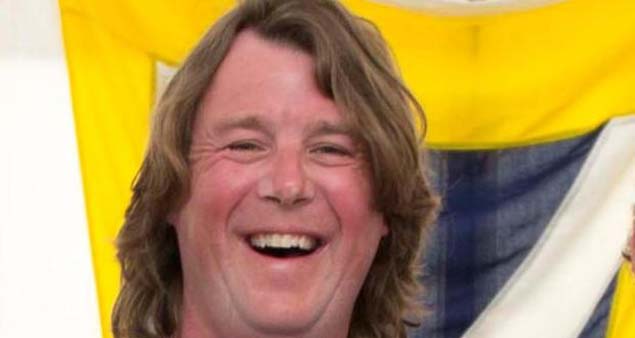 Fools Gold skipper Rob McConnell
Fools Gold skipper Rob McConnell
As part of the Fools Gold crew, sailmaker Graham Curran will be trimming aboard Rob McConnell's A 35, Fools Gold, which was the overall winner of the 2017 Sovereigns Week. Fools Gold then goes on to Compete in the IRC Worlds in the Hague in Holland in August.
Anorher sailor in Cowes is pro Mark Mansfield who will sail in the IRC Europeans in Cowes as Tactician on John Smart's J109, Jukebox. Mansfield then moves on a few days later to do the same role on Paul Gibbons Quarter Tonner, Anchor Challenge at the Quarter Ton Cup in Cowes.
Yachts from across Europe are gathering in Cowes for the start of IRC European Championship on Sunday 10 June. This is the third running of the annual championship for RORC and UNCL's jointly developed IRC rating system, but the first in IRC's spiritual home, following events in Cork and Marseille. To celebrate this, the 2018 IRC European Championship will be the most challenging yet, with a week-long format, mixing both inshore and offshore racing, including a long offshore of 24-36 hours duration and a race around the Isle of Wight.
While the bulk of the fleet is from the UK, with Mike Bartholomew's Tokoloshe and James Neville's Ino XXX the highest-rated competing, others are making the trip from further afield.
Chasing the FAST 40+ yachts around the course will be Yigit Cula's Ker 41 Anything - all the way from Turkey - and the globetrotting Selma Racing, skippered by Artur Skrzyszowski from Poland. This Reichel Pugh 41 has already campaigned as far afield as the Rolex Fastnet Race, Sevenstar Round Britain and Ireland, Rolex Sydney Hobart Yacht Race and Rolex Middle Sea.
"We are building a competitive team that will be capable of winning races in the future," explains Skrzyszowski. "The goal of the Selma Racing Foundation is to inspire, promote and support Polish sailors in offshore racing. The team is made up of skilled sailors with racing backgrounds as well as novices and amateurs with experience in offshore racing, Olympic classes, match racing, and also expedition sailing to Antarctica and Cape Horn."
While Tokoloshe and Ino XXX will be match racing their way around the front of the fleet, a similar one-on-one battle will be taking place between the two Turkish-built Mark Mills-designed MAT 1180s - Tor McLaren's Gallivanter and from the US, Christian Zugel's Tschuss.
The competition will also be lively between the Performance 40s, the newly-created class for boats with an IRC TCC of 1.070-1.145, 11.15m-14.1m hull length, the displacement-length ratio of 130-200 and draft of <2.65m.
Here Roger Bowden's King 40 Nifty is likely to lead the field on the water, while there will be the usual nip and tuck between a posse of First 40s - from the Netherlands, Frans and Carla Rodenburg's Elke, Alex and Andy Moore's TiLT Racing, the team on Rob Bottomley's Adventurer and La Réponse of Royal Ocean Racing Club Admiral Andrew McIrvine. The Performance 40s will also include regular Commodores' Cup competitor Roderick Stuart and Bill Ram's Corby 37 Aurora from Scotland.
A number of the most powerful entries will be coming from France and most are very familiar names in RORC racing. This includes three time Commodores' Cup competitor Emmanuel Le Men and his Val Andre Yacht Club crew on board the First 40.7 Pen Koent. Then there are three JPK 1080s: Most prominent is Arnaud Delamare and Eric Mordret's Dream Pearls that dominated IRC Three in last year's RORC Seasons Points Championship. No less potent are Marc Alperovitch's Timeline and Jean-Eudes Renier's Shaitain being campaigned by Jock Wishart.
While the majority of the competitors in the IRC Europeans know the waters of the Solent and Channel well, some are new to it. Michael Mollmann and his Danish crew on their X-37 Hansen are one. This 14-year-old campaign is a regular at the ORC World Championship. For the first time this year's World Championship in The Hague is being jointly scored under both ORC and IRC. Aside from coming to the Solent to race "somewhere new", Mollann says they are using the Europeans to find out how their X-37 performs under IRC.
Incorporating the Commodores' Cup
The Commodores' Cup, Royal Ocean Racing Club's biennial event between three boat Corinthian teams, will take place within the IRC European Championship this year.
To help ensure this works, the club has lifted almost all of the rating and entry restrictions. For example, there are now no rating bands into which each of the three boats must fall. Neither does one of three having to be a 'big boat'. Equally, teams now no longer have to represent a nation or a region.
Simply put - any three boats of any size from any nation can form a team. They can represent the same nation, the same region, the same club or they can just be three boats from different countries, whose like-minded owners feel they can race as a competitive team. Any three boats entered in the IRC Europeans can form a team. The only limitation on Commodores' Cup entries is that their crew can only include one World Sailing Group 3 'professional' (the number of pros is unlimited on IRC Europeans boats not competing in the Commodores' Cup). One of the strongest Commodores' Cup teams is likely to be the British trio of Andrew McIrvine's First 40 La Réponse, Ed Fishwick's Sun Fast 3600 Redshift Reloaded and 'boat of the moment', the JPK 1180 Sunrise, recently acquired by Tom Kneen.
So why is the Commodores' Cup special? Aside from its long, illustrious history dating back to when the US team of Don Smith's Falcon, Oliver Woodhouse Grin's Collaboration and Peter Gordon's Gaucho won the first event in 1992, the event is a rarity.
As RORC Admiral Andrew McIrvine explains: "The Commodores' Cup remains the only team event in the world left for Corinthian sailors. It is a particularly intensive week of both inshore and offshore racing, which is unusual these days. It is a very tough competition, particularly between the UK and France. I am very much looking forward to this intensity."
Fools Gold Wins at Abersoch Keelboat Race Week
Waterford Harbour Sailing Club's A35, Fools Gold, skippered by Rob McConnell returned to Wales at the weekend for another regatta campaign. Having won the IRC Welsh Nationals in August in Pwllheli, the Dunmore East boat has gone on to win Abersoch Keelboat Week, IRC division one by half a point.
Fools Gold was up against a range of cruiser–racers in her ten boat fleet including J109s, J97s, Corbys and a Beneteau 234.7. Results are here.
16–year–old helmsman, Dunmore East 420 dinghy champion, Geoff Power got his first taste of cruiser–racing on the tiller of Fools Gold.
A two race retirement after a broken rig, was no barrier for McConnell's crew who, among others, squeezed out ISORA overall leader Mojito for the win.
The Wateford crew also won 'Best Visiting Boat' Trophy at Abersoch. The win completes a successful season for McConnell who also clinched Sovereigns Cup overall honours in July.




























